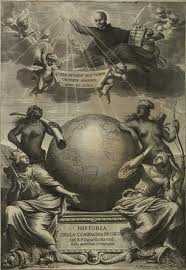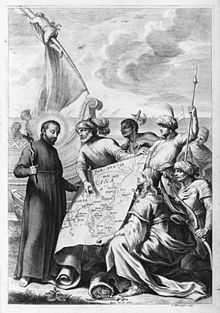Istoria della Compagnia di Gesu

The monumental Istoria della Compagnia di Gesu (Rome, 1650–1673), in 6 folio volumes by the Jesuit man of letters and historian Daniello Bartoli is the most extensive classic of Italian literature, over ten thousand pages long.[1] It begins the centenary history of the Jesuits between 1540 and 1640 with an authoritative if somewhat ponderous biography of the founder Ignatius Loyola.
Della Vita e dell'Instituto di S. Ignatio
The first part of Bartoli's undertaking begins wirh an introduction to his general plan which after this biography wiil extend to the four corners of the earth. In addition to the library of manuscripts in the Jesuit archives, Bartoli acknowledges the writings of his predecessors, Juan de Polanco, Loyola's secretary, and biographers Pedro de Ribadeneira, Giovanni Pietro Maffei and Niccolo Orlandini. The work is organized in five books, of which the third is a disquisition on the Jesuit Institutes and Constitution. Book 4 is dedicated to the virtues and the death of Ignatius. Book 5 is dedicated to the saint's miracles After the first edition [2] Ignatio De Lazzeri brought out a second edition (Rome, 1659) with the programmatic frontispiece of Cornelis Bloemaert
L'Asia

Particularly fascinating and exotic are the three parts of his Asia narrating the stories of Francis Xavier and the Jesuits in the India, Japan and China.
L'Asia (1653) in eight books, undertakes the story of the missions in India, concentrating on the Portuguese colony in Goa, where Xavier arrived in 1542. Saint Paul's College, Goa was the center of the Asian missionary enterprise with its schools and printing presses where Henrique Henriques wrote Christian texts and the first Tamil dictionary. The work also deals with the mission of Xavier to Japan in 1549 in Book 3 and the story of the first Jesuits in Japan under Cosme de Torres up to 1570 in Book 8.[3] Bartoli narrates the story of the Jesuit mission to Akbar the Great in Fatehpur Sikri of Rodolfo Acquaviva and of his martyrdom in Salcete in 1581 in a smaller work of 1653 Missione al Gran Mogor del p. Ridolfo Acquaviva[4] This was added to the third edition of L'Asia in 1667.
Il Giappone (1660) in five books is a most extensive history of the Jesuit Kirishitan mission in Japan from the successes during the Sengoku period through its annihilation enforced by the Tokugawa shogunate beginning the Sakoku era.[5] Book 1 and 2 recounts the flourishing missions in Japan of the sixteenth century during the rule of Oda Nobunaga and Toyotomi Hideyoshi under Francisco Cabral and Alessandro Valignano and the nanban trade trading monopoly the Jesuits secured in Nagasaki. Notable linguist missionaries such as Luis Frois and Joao Rodrigues (missionary) and daimyo converts, such as Otomo Sorin are featured as well as and the Tensho Embassy to Rome. The eradication of the Japanese Kirishitan begins in 1597 with the crucifixion of the Twenty-six Martyrs of Japan under Hideyoshi beginning Bartoli's martyrology of Japanese Catholics recounted in Books 3, 4 and 5 under the first three Tokugawa shoguns.
La Cina (1663) recounts the intellectual and intercultural adventure of the Jesuit missions in China centering around the eminent Jesuit Sinologists Michele Ruggieri and Matteo Ricci and their successors at the imperial court.
L'Europa
As a universal history of the first Jesuit century Bartoli announces in his introduction to the first volume a plan to cover the world in its four corners (see the iconographic illustration) whereby the seated Orient and Europe would be followed by Africa and the Americas yet standing. After the fascinating and also excruciating epic of the Asia Bartoli turns his pen and wits closer to home beginning his Europa with the dramatic story of the English missions, L'Inghilterra (1667) featuring Thomas Pounde, Edmund Campion, Robert Persons, John Gerard, Robert Southwell and Henry Garnet and their connections to the Throckmorton Plot, the Babington Plot under Elizabeth and the Gunpowder Plot under James and the vicissitudes of the aristocratic Recusant community to whom they ministered.[6] The English College of Rome and the Jesuit schools on the Continent for English Catholics, such as the Colleges of St Omer, Bruges and Liege are at the center of his institutional interests.[7]
The last history he completed narrates the auspicious Renaissance beginnings of the Italian Society of Jesus in L'Italia, prima parte dell'Europa (1673) from Loyola's arrival in Rome in 1537 up to the election of the third Jesuit general Francis Borgia in 1565. This includes much early institutional history already in the biography of the founder, as well as the origins of Jesuit education in the Jesuit college of Messina. The Jesuits fortunes at the major Renaissance courts are recounted as well as the "vocationes illustres" in Padua in 1559 of Antonio Possevino and Achille Gagliardi and his brothers, the second generation who would confirm the Italian leadership of the Society under Claudio Acquaviva.
Degli Uomini e dei Fatti della Compagnia di Gesu: Memorie storiche
By the time he produced his last history, after nearly three decades of writing, Bartoli was 65. Seeing that his historiographical commitment to Jesuit history in the four corners of the world was beyond him, the elderly Bartoli assembled a chronicle of the first fifty years of the order's history between 1540 and 1590. This work was left in manuscript at his death in 1685 in the Jesuit archives in Rome until it was published by Giacinto Marietti, Turin printer of the complete edition of Bartoli's works, between 1847 and 1856 in five volumes.
References; Editions & Online Links
- ↑ Opere del p. Daniello Bartoli vols. 1-18 , in the complete edition, available on Google Books, (Marietti, Turin, 1825-42) 34 vols.
- ↑ (Roma: Manelfi, 1650)
- ↑ (Roma: Manelfi. 1653); (Genoa: Guasco, 1656)
- ↑ (Rome: G. M. Salvioni: 1714)
- ↑ Over two thousand pages in the standard Marietti edition of Bartoli's Opere. An anthology with extracts from each book appeared with a essay by Nino Majellano, Giappone, Istoria della Compagnia di Gesu, Spirali, Milan: 1985. Ebook reprints of the Marietti edition are now available.
- ↑ See on Bartoli's English sources,for example, Elizabeth Patton, Dorothy Arundell's “Acts of Father John Cornelius”: “We Should Hear from Her, Herself—She Who Left a Record of It in These Words”
- ↑ Online there is a Bologna edition of 1676